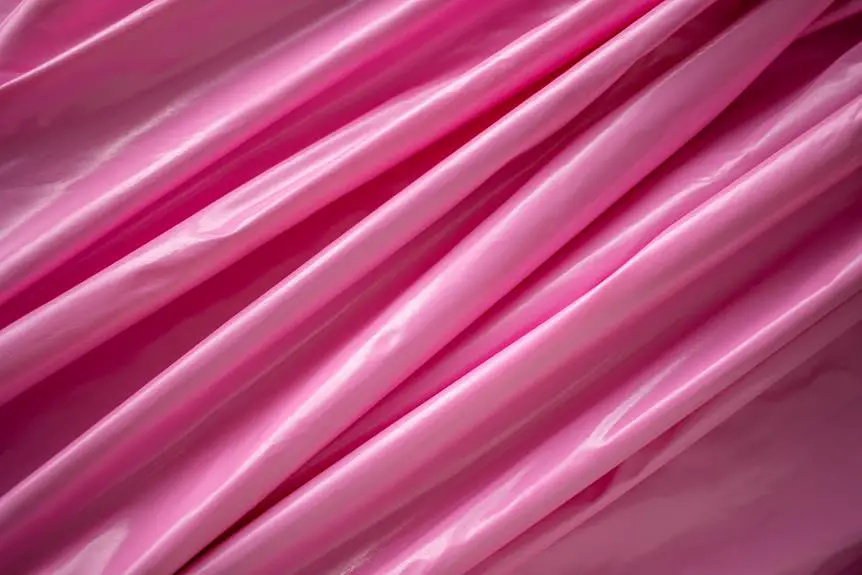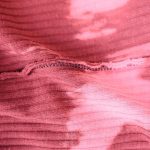Looking to achieve a deep, rich hue for your fabric, like marinating a tender cut of meat for maximum flavor? You may wonder, 'Can I soak fabric in Rit dye overnight?'
This guide explores the potential benefits, risks, and techniques for achieving vibrant colors through extended soaking. Whether you're a seasoned crafter or a dyeing enthusiast seeking mastery, understanding the intricacies of overnight soaking can elevate your dyeing results.
By considering fabric types, precautions, and alternative methods, you can unlock the potential of Rit dye for your projects.
So, let's delve into the world of overnight soaking with Rit dye and uncover the possibilities it holds for your fabric creations.
Key Takeaways
- Following Rit Dye's soaking time recommendations ensures optimal color absorption.
- Overnight soaking enhances color intensity and saturation levels.
- Extended soaking allows for deeper dye penetration and long-lasting colors.
- Cotton, linen, wool, and silk fabrics are suitable for overnight soaking, while synthetic materials should be avoided.
Rit Dye Soaking Time Recommendations
You should follow Rit Dye's soaking time recommendations to ensure optimal color absorption. Adhering to these guidelines offers several benefits.
Proper soaking time allows the fabric to absorb the dye evenly, resulting in vibrant and long-lasting colors. This ensures that the dye penetrates the fibers thoroughly, leading to a more uniform and professional-looking finish.
However, there are risks associated with deviating from these recommendations. Too short of a soak may result in incomplete dye absorption, leading to a faded or patchy appearance. On the other hand, soaking the fabric for too long can potentially damage the fibers, causing the material to become weak or disintegrate.
It's crucial to strike the right balance to achieve the desired color intensity without compromising the fabric's integrity. By following Rit Dye's soaking time recommendations, you can maximize dye absorption while minimizing the risk of fabric damage, ultimately achieving the best results for your dyeing project.
Potential Benefits of Overnight Soaking
The extended soaking period overnight can enhance the depth and richness of the dye's color penetration into the fabric. This prolonged exposure allows the dye to saturate the fabric at a more thorough and even level, resulting in several potential benefits:
- Enhanced Color Intensity: Allowing the fabric to soak in Rit dye overnight can lead to a more vibrant and intense color payoff. The extended duration enables the dye to fully penetrate the fibers, resulting in a more saturated and rich hue.
- Improved Saturation Levels: Overnight soaking promotes higher saturation levels within the fabric. This means that the dye has more time to spread and seep into the fabric evenly, reducing the likelihood of splotchy or uneven coloring.
- Deeper Dye Penetration: Longer soaking times allow the dye to penetrate deeper into the fabric, resulting in a more even and long-lasting color. This can be particularly beneficial for achieving dark or intense colors that require thorough penetration for optimal results.
Risks and Considerations
When soaking fabric in Rit dye overnight, it's important to consider the potential risks and drawbacks.
Dye absorption levels may vary greatly depending on the type of fabric, potentially leading to uneven or unexpected results.
Additionally, prolonged exposure to the dye solution could potentially damage delicate or sensitive fabrics.
Dye Absorption Levels
Wondering how long you should soak your fabric in Rit dye to achieve the desired color intensity? The key to understanding dye absorption levels lies in the processes of dye penetration and fiber reactivity. It's essential to consider the dye's colorfastness and the fabric's ability to bond with the dye.
Here are important factors to consider:
- Dye Penetration: The duration of soaking affects how deeply the dye penetrates the fabric, impacting the color intensity and vibrancy.
- Colorfastness: Longer soaking times can enhance colorfastness, ensuring the dye remains vibrant after washing.
- Fiber Reactivity and Dye Bonding: Different fabrics react to dye in varying ways, influencing how effectively the dye bonds with the material.
Understanding these factors will help you determine the optimal soaking time for achieving your desired dye absorption levels.
Fabric Damage Potential
Considering the potential for fabric damage, soaking fabric in Rit dye overnight may result in excessive color absorption and uneven dye distribution, potentially leading to a blotchy or splotchy appearance. The prolonged exposure to the dye can cause the fabric to absorb more color than intended, resulting in a darker shade than desired.
Additionally, certain fabrics may be more susceptible to damage from prolonged exposure to dye, leading to a weakened or altered texture. This can be particularly problematic for delicate or natural fibers. Furthermore, the extended dye penetration may compromise the structural integrity of the fabric, resulting in potential fraying or weakening of the material.
It's crucial to carefully consider the fabric type and condition before opting for an overnight dye soak to ensure fabric preservation and avoid unintentional damage.
Fabric Types Suitable for Overnight Soaking
You'll want to consider using cotton and linen fabrics for overnight soaking, as they're highly absorbent and take well to dye.
Natural fiber materials like wool and silk also work well with overnight soaking and result in vibrant colors.
It's best to avoid synthetic materials, as they may not absorb the dye effectively and could result in uneven coloring.
Cotton and Linen Fabrics
For cotton and linen fabrics, overnight soaking in Rit dye can result in vibrant and long-lasting color. When preparing cotton or linen fabrics for dyeing, it's important to wash them thoroughly to remove any dirt, oils, or finishes that could inhibit dye absorption. This ensures that the fabric is ready to fully take on the dye, leading to intense and even coloration.
Additionally, pre-wetting the fabric before soaking it in the dye can help promote more uniform dye penetration, resulting in consistent color intensity throughout the material. Remember to stir the fabric periodically while soaking to guarantee that the dye saturates the fabric evenly.
Following these fabric preparation steps can enhance the color intensity and longevity of the dye on cotton and linen fabrics.
Natural Fiber Materials
Natural fiber materials such as cotton and linen are suitable for overnight soaking in Rit dye to achieve vibrant and long-lasting colors. When considering natural dyeing methods, sustainability is a key factor to keep in mind. Fabric preparation is crucial for successful dyeing, as it ensures that the dye adheres evenly and with good color fastness. Here's a table summarizing the fabric types suitable for overnight soaking in Rit dye:
| Fabric Type | Suitability for Rit Dye Overnight Soaking |
|---|---|
| Cotton | Highly suitable |
| Linen | Highly suitable |
| Silk | Suitable with caution |
Choosing natural fiber materials not only supports sustainable practices but also allows for beautiful, rich color outcomes. Proper fabric preparation and understanding color fastness are essential for achieving the best results with Rit dye.
Avoid Synthetic Materials
Avoid soaking synthetic materials in Rit dye overnight to prevent unsatisfactory color results and potential damage to the fabric. Synthetic material limitations include an inability to absorb dye as effectively as natural fibers, leading to lighter or uneven coloring.
Furthermore, prolonged exposure to the dye can cause synthetic fabrics to break down or become damaged, affecting the overall quality and integrity of the material. Effects on unnatural fibers may include a faded or splotchy appearance, as well as an increased risk of shrinkage or distortion.
When considering overnight dye soaking, opt for natural fabrics such as cotton, linen, or silk to achieve the best results without compromising the fabric's durability or appearance.
Techniques for Achieving Deep Colors
To achieve deep colors when dyeing fabric with Rit dye, immerse the fabric in the dye solution for an extended period of time, ensuring thorough saturation. Start by preparing a dye bath with the appropriate dye concentration for the fabric you're dyeing. Follow the instructions on the Rit dye package for the recommended dye-to-water ratio to achieve the deep color you desire.
Once the fabric is submerged in the dye bath, apply heat to enhance the color absorption process. Use a stovetop or a washing machine to maintain a consistent and elevated temperature, as heat application significantly contributes to achieving vibrant, deep colors.
Keep the fabric in the dye bath for an extended period, allowing the dye to penetrate the fibers completely. Be patient, as this process may take several hours or even overnight, depending on the fabric and the depth of color you wish to achieve.
Precautions to Take Before Overnight Soaking
Before overnight soaking fabric in Rit dye, conduct a colorfastness test to ensure the fabric can withstand the extended dyeing process. This precaution helps prevent damage to the fabric and ensures the dye adheres evenly.
Once you've confirmed the fabric's suitability for overnight soaking, there are additional safety measures to consider:
- Wear protective gloves and clothing to avoid skin contact with the dye, as Rit dye contains chemicals that can irritate skin.
- Protect the work area by covering surfaces with plastic or old towels to prevent accidental spills and stains.
- Use a well-ventilated area to minimize inhalation of dye fumes, or consider wearing a mask if ventilation is limited.
Taking these precautions not only ensures your safety but also helps in achieving the desired results without damaging the fabric or risking exposure to potentially harmful chemicals.
Alternative Methods for Intense Dyeing
Consider employing immersion dyeing for achieving intense color saturation in your fabric. One alternative method for intense dyeing is the boiling method. This technique involves boiling the fabric in a large pot with the dye solution. The high temperature helps the color penetrate deeply into the fabric, resulting in vibrant and long-lasting hues. It's essential to monitor the boiling process carefully to prevent damage to the fabric and achieve the desired color intensity.
Another effective method is double dipping, which enhances color saturation. After the initial dyeing process, allow the fabric to dry completely, then redye it with the same or a different color. This double dipping technique intensifies the color and creates rich, multi-dimensional tones. Ensure that the fabric is thoroughly rinsed and dried between each dyeing session to prevent color bleeding and ensure the best results.
Both the boiling method and double dipping can be powerful techniques for achieving intense dyeing results. However, it's important to carefully follow dye instructions and safety precautions to ensure the best outcome for your fabric.
Frequently Asked Questions
Can I Use Rit Dye for Tie-Dyeing Fabric?
You can use Rit Dye for tie-dyeing fabric. It works best on natural fibers like cotton and rayon. Follow the instructions for best results. Experiment with different techniques to create unique and vibrant tie-dye designs.
Is It Safe to Soak Delicate Fabrics Like Silk or Wool in Rit Dye Overnight?
Yes, it's generally safe to soak delicate fabrics like silk or wool in Rit dye overnight. However, be cautious with prolonged soaking for vibrant colors, as it may affect fabric safety and dye fastness. Always prioritize fabric care.
What Are Some Alternative Methods for Achieving Vibrant Colors Without Overnight Soaking?
To achieve vibrant colors without overnight soaking, consider using natural dyes or cold water dyeing methods. Natural dyes like turmeric, beet, or avocado can yield beautiful hues, while cold water dyeing preserves delicate fabrics and produces rich colors.
Will Soaking Fabric in Rit Dye Overnight Cause the Color to Fade or Bleed When Washed?
Soaking fabric in Rit dye overnight may cause the color to fade or bleed when washed. Conduct a colorfastness test before dyeing, prepare the fabric properly, ensure dye fixation, and use gentle washing techniques to maintain the color.
Are There Any Special Considerations for Soaking Large or Bulky Items, Such as Blankets or Curtains, in Rit Dye Overnight?
When soaking large items in Rit dye overnight, take precautions to ensure even color penetration and prevent dye bleeding. Carefully follow fabric care instructions and use a spacious container for optimal results.
- Tetron Fabric for Marine Applications: Durability and Use Cases - June 18, 2025
- Tetron Fabric for Outdoor Furniture: Weather Resistance and Care - June 18, 2025
- Tetron Fabric for Wall Coverings: Style and Application Tips - June 18, 2025







